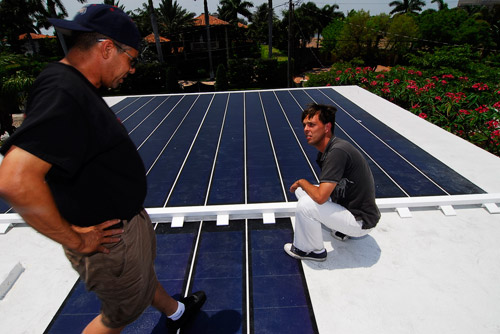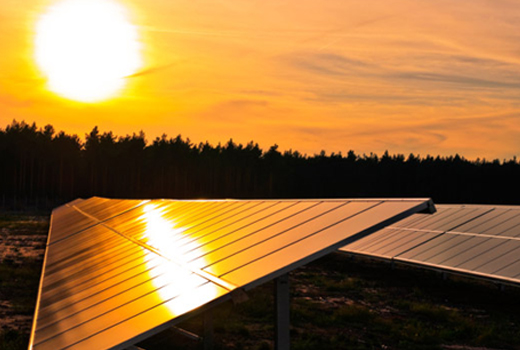Mage Solar Understanding Solar Basics
It doesn’t take a solar expert to realize that the magnificent concept of clean, reliable and easy to deploy solar energy is unstoppably making its way into the collective conscience of society. Solar is finally going mainstream in America, and it won’t be long before on-site generation of safe and infinitely renewable energy becomes as normal as getting milk from the refrigerator. Indeed, according to a recent national survey conducted by independent polling firm Kelton Research, 94 percent of Americans think it is important for the nation to develop and use solar energy. This was consistent across all political party affiliations. Even more so, more than one-half (51 percent) of the country would choose to work in the solar industry if they were to start working in renewable energy. And, nearly one-half (49 percent) of Americans who were considering solar for their home or business at the time of the survey stated that they planned to make a decision to adopt solar in less than one year.
When it comes to American business leaders, manufacturers have discovered use of solar energy as a way to significantly reduce spiraling energy costs. In addition, these businesses are generating consumer goodwill by advertising that their products are “made with solar energy” prominently on their recyclable packaging. The idea of harvesting the sun’s rays is catching on and gaining popularity compared to other environmentally and politically questionable energy practices.
A recent study by New York University and Yale professors found that solar energy is actually contagious. The more we see it, the more we are willing to adopt it. The researchers, in fact, measured “a 9.28 percent increase in the street level adoption rate” after only 1 percent increase in the street-level installed base (Bollinger/Gillingham; Peer Effects in the Diffusion of Solar Photovoltaic Panels; Yale School of Forestry & Environmental Studies; December 7, 2011). In other words, after only 1 percent of a neighborhood solarizes and installs a system, a successive increase of more than 9 percent can be measured afterwards – neighbors who see the system working are adapting the clean energy technology themselves.
Just as important as exposure to actual solar installations is the adaption process. Another key ingredient for success of clean energies is education and knowledge. Only by truly understanding the possibilities and benefits of the earth’s most abundant energy source will we be able to fully optimize its utilization. Therefore, it is important to understand the plethora of solar technologies available today, which are making this resource such an exciting, versatile option.

Illustrated by Infographic World
Electricity generating solar technologies (photovoltaics or “PV” for short) are the most common solar applications used today. They can be off-grid and backed by batteries – for example, during temporary power outages or in remote areas with little or no access to the grid – or tied to the grid. The latter application uses the grid as a “giant battery” as it feeds into it during peak solar production time (from around noon into the late afternoon when the sun’s output is the strongest) and pulls from it at night or on an especially dark, cloudy day.
The two mainstream technologies today are crystalline silicone and thin film. Both function using the same principle: Sunlight strikes the cell surface and sets an electron chain reaction into motion, which creates electron-hole pairs. The flow of these pairs is the current that produces power – the more, the better, of course. That is why high-efficiency, positive tolerances and long life expectancy are so important when it comes to solar.
Crystalline Silicone. The great majority (85-90 percent) of photovoltaic applications use crystalline silicone, one of the most common elements on earth. The mono or polycrystalline modules available on the market today are truly tried and proven, and as efficient and well-engineered as never before – true marvels in versatility. From a few kilowatts to mega- and even gigawatts, photovoltaic modules are perfectly scalable and fit to power an electric vehicle charging station or a house just as easily as a huge factory or utility-scale solar farm. They can be attached on ground-mounted poles, roofs, canopies or awnings at an ideal sun-catching pitch to optimize yield. On limited spaces like parking lots, for example, solar trackers have proven to be amazingly efficient as they can follow the sun’s path all day long.
One of the greatest advantages is, without doubt, the durability and efficiency of these modules. Several leading manufacturers are building modules that can withstand severe wind loads, salt water, ammonia or even considerable hail. And, these modules will still produce most of their power after two decades and more, with the gold standard being an 80 percent value of their nominal power after 30 years. Another great benefit is areas hit by disaster, for example, can restore power quickly and safely with PV, as can regions with extreme weather conditions.
Building Integrated Photovoltaics (BIPV). PV can be an integral architectural feature of a building. Sometimes this is done with such skill that it is unnoticeable to the public eye, for example, a façade or breezeway made of solar panels. Although existing structures can be retrofitted with BIPV, the most amazing and aesthetically pleasing results are probably the ones where innovative architects designed the building with BIPV in mind. Another attractive aspect of BIPV is its ability to offset building materials and labor costs. Hence, the modules are part of the building’s structure, not an additional installation.
Thin Film. With only about 10 to 15 percent market share, thin film is a lightweight technology for micro- to macro-scale applications. A thin film of amorphous silicon is placed onto stainless steel sheets or foil for use on backpacks, tents, mobile phone chargers or on a roll to cover a roof top. This is an extremely portable and versatile use of the technology.
When applied on glass plates, thin film gains more efficiency (about 7 to 9 percent) and durability, but it is more susceptible to damage and less robust than crystalline silicone. (The average life expectancy is about 12 years.)

Photo Credit: Kenfields|Contractors installing thin film.
Solar Thermal Collectors. Many people mention how they would love to have solar to heat water for their pools or showers. Much like a water hose left laying in the sun or a camping shower, solar thermal collectors heat water in absorber plates or tubes (usually mounted on a roof), which is then pumped into a storage tank and kept at about 50° C or 122° F. An average 50-gallon household heater powered by the sun can replace roughly 12 barrels of oil per year and easily provide up to 85 percent of the total hot water needs for a family of four. In places where large quantities of hot water are constantly used – like kitchens or laundries – this efficient technology is an extremely cost-effective choice.
Concentrated Solar. This application is more or less a mix of both a heat generating and electricity generating technology, and used only in large utility-scale applications. Thousands of parabolic or trough-like collectors absorb the sunlight and act as powerful little mirrors, heating oil or liquid salt. This substance, in turn, can heat a huge water tank for use as solar thermal energy (Concentrated Solar Thermal) or create enough steam to drive turbines, which provide electricity (Concentrated Solar Power). At a certain point, the tanks can become so hot that these power plants have the capability and force to actually run 24 hours, even during nighttime.
In no way does this short overview claim to be all-inclusive. And, frankly, one of the most exciting features about the solar industry is its innovation and creativity, which produces new technologies and applications almost daily. Some will stand the test of time and prove efficient and practical; others may not be able to succeed outside the research lab. What is safe to say, however, is that the mainstream technologies listed above come with several decades of smart engineering and superior “field-testing.” For instance, Germany, which is not exactly known as a land of ample sunshine, has installed more than 17 GW of solar on its roofs and ground mounts, and is the world champion of solar, followed by Italy and Spain. The many solar-users and array owners there are a testimony to the fact that the sun makes its gifts available to all of us.

© Paul Langrock, 2009|Concentrated solar for large utility-scale applications.





























